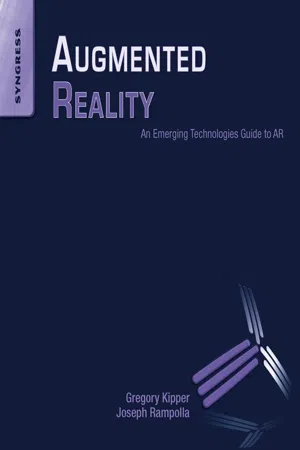• What is Augmented Reality?
• How Augmented Reality Works
• A History of Augmented Reality
• Augmented Reality of Today
• The Differences between Augmented Reality and Virtual Reality
• Challenges with Augmented Reality
• The Opportunities for Augmented Reality
The Definition of Augmented Reality
Augmented Reality (AR) is a variation of a Virtual Environment (VE), or Virtual Reality (VR) as it is more commonly called. Virtual Reality technologies completely immerse a user inside a synthetic environment and while immersed, the user cannot see the real world around him. In contrast, Augmented Reality is taking digital or computer generated information, whether it be images, audio, video, and touch or haptic sensations and overlaying them over in a real-time environment. Augmented Reality technically can be used to enhance all five senses, but its most common present-day use is visual. Unlike Virtual Reality, Augmented Reality allows the user to see the real world, with virtual objects superimposed upon or composited with the real world. Therefore, AR supplements reality, rather than completely replacing it as depicted in Figure 1.1 Augmented Reality can be thought of as the blend, or the “middle ground,” between the completely synthetic and the completely real.
Figure 1.1 A 3D Graphic or Model is Superimposed on the Real-World Object Through the Use of a Smartphone
One of the easiest examples is a heads-up display, or HUD, used by fighter pilots. It is likely we have all seen examples of a HUD in movies or television documentaries. A HUD gives the pilot a digital overlay that shows an artificial horizon, the digital altitude, digital speed, and other information while looking out the cockpit window as shown in Figure 1.2 Another example that has appeared in the past few years is the artificial “first down” line Figure 1.3 that helps football viewers watching the game on TV know how far the offensive team needs to go to get a first down. These examples are somewhat straightforward compared to some of what we will explore in the rest of this book.
Figure 1.2 Fighter Jet Heads-up Display
Figure 1.3 An Augmented “First Down” Line
Augmented Reality can also be used to remove real-world information, not just add to it. A basic example is this the Vulcan Tourism Transporter App that creates the transporter “beaming” effect from the Star Trek series. A person sitting or object put in front of the transporter pad can be dematerialized or rematerialized using Augmented Reality as depicted in Figure 1.4.
Figure 1.4 The AR Transporter Room Application Removes a Physical Object from View
Building on the basic definition and descriptions of AR’s capabilities let us expand a bit further and outline the three characteristics that need to be present for true Augmented Reality:
1. AR combines real and virtual information.
2. AR is interactive in real time.
3. AR operates and is used in a 3D environment.
Augmented Reality really allows for information to be presented visually that the user would not otherwise be able to detect. Just as there are millions of bits of information being transmitted all around us right now on some wireless frequency or another, we as people would be totally unaware of it without the mobile phones, tablets, and laptops that allow us to effectively channel the information. Augmented Reality, much like other graphical interfaces, gives us the ability to bring usable information into the visual spectrum in real time wherever we are. Augmented Reality is not just one technology. It is the combination of several technologies that work together to bring digital information into visual perception. AR is a highly compelling, virtually endless, collection of technology-assisted experiences that helps create the real-time Web.
As Gene Becker of Lightning Laboratories puts it, Augmented Reality is:
• a technology.
• a field of research.
• a vision of future computing.
• an emerging commercial industry.
• a new medium for creative expression.
Interestingly enough the same list could have, and may have, been applied to the 2D graphical user interface that became popular in the 1980s.
What AR is Not
There are more than enough examples today of digitally enhanced media, however it does not necessarily mean that all of them constitute “augmented” reality. An image altered in Photoshop, or any other type of 2D overlay, is not AR. It also does not include film or television. While movies such as “Jurassic Park” and “Avatar” feature photorealistic virtual objects seamlessly blended with a real environment in 3D, they are not interactive and thus not AR. In contrast, the football game example mentioned earlier uses a live feed and computers to create a virtual line of scrimmage on the display in real time does constitute AR, whereas a motion picture that is carefully scripted, filmed, and processed does not.
Augmented Reality is sometimes confused with “visual searching”, particularly in a mobile environment. Visual searching is defined as an active scan of the visual environment for a particular object or feature among other objects or features. Programs such as Google Goggles and Nokia’s Point and Find allow the user to search from their cell phones by capturing an image and finding relevant information about that image. In some ways it begins the same way AR does with “recognition” of an object and it is interactive in real time but it fails to meet the rules of actually combining real and virtual information and operating in a 3D environment.
The Components of Augmented Reality
Now that we’ve covered the basics of what Augmented Reality is, and isn’t we’ll start digging a little deeper into the technology and learn about all the pieces that make AR work. There are a number of necessary components to make the whole process work as well as the different types of platforms that can be used for Augmented Reality. In Chapter Two we’ll explore what makes Augmented Reality work in greater detail but for now the list below is a summary of the core components needed for both fixed and mobile environments:
Hardware:
• a computer, either a PC or a mobile device
• a monitor or display screen
• a camera
• tracking and sensing systems (GPS, compass, accelerometer)
• a network infrastructure
• a marker: markers are physical objects or places where the real and Virtual Environments are fused together. This is what the computer identifies as the place where digital information is to be presented.
Software:
• an app or program running locally
• Web services
• a content server
Augmented Reality Platforms
Now that we’ve touched on the necessary components here are four platforms by which Augmented Reality is used today. They are:
1. Personal Computers with Webcams: Since most PCs contain some, if not all, the needed components for viewing Augmented Reality on this platform are an obvious choice. Because of the fixed nature of the device (compared to mobile phones and tablets), a marker is placed within view of a Webcam, which shows a live feed. Once it identifies the marker, it creates the augmentation on the screen for the user to interact w...




